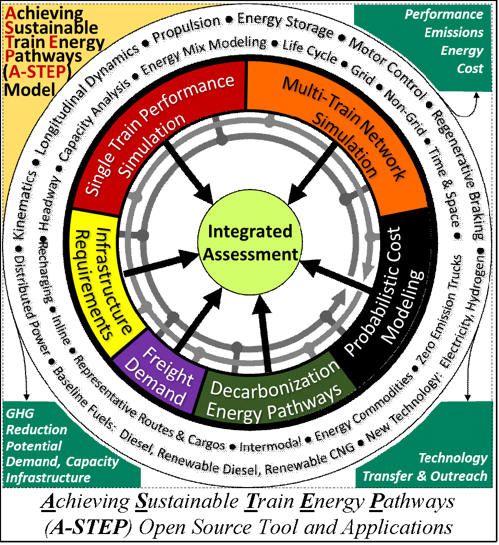CCEE researchers tackle rail decarbonization with innovative A-STEP software tool

 As the effects of climate change grow ever present in our everyday lives, engineers and other researchers are constantly seeking new and innovative ways to cut down our carbon footprint — including the ways transportation modes are fueled.
As the effects of climate change grow ever present in our everyday lives, engineers and other researchers are constantly seeking new and innovative ways to cut down our carbon footprint — including the ways transportation modes are fueled.
The transportation sector emits the highest amount of greenhouse gas emissions of all the U.S. sectors, according to the U.S. Department of Transportation. The rail sector, in particular, contributes 2% of those emissions.
CCEE researchers, sponsored by ARPA-E, have worked with NC State’s Institute for Transportation Research and Education, DB E.C.O North America Inc., Virginia Tech Transportation Institute and Oregon State University, to develop a toolset that can be used to identify ways to reduce freight rail’s carbon footprint, expanding the use of lower emission power sources. A-STEP (Achieving Sustainable Train Energy Pathways) is a first-of-its-kind, integrated, open-source software tool that can help guide freight rail decarbonization decision-making.
“There’s no other tool like this in the public domain,” said CCEE Professor George List, who was PI on the project. “Ten years ago, decarbonization seemed like an unattainable goal. Now, more companies and organizations are embracing the idea; it is becoming technologically feasible.”
A-STEP provides ways to study energy use scenarios for individual trains, networks of trains, battery and hydrogen charging stations, national energy sourcing and pricing, and overall decarbonization costs and environmental impacts. A-STEP gives analysts an ability to study the challenges of making such change happen. Completely amenable to analyst specified inputs and parameter values, it can be customized to provide outputs for a wide variety of assumptions about future energy conditions and technological advances. Written in Python, C++, and VB.Net, A-STEP can be implemented on both Windows and Linux-based platforms.
A-STEP includes five specific analysis tools:
- SysDecarb: Examines the cost and environmental impacts of various decarbonization options and scenarios for the years 2025-50.
- OneTrain: Examines energy consumption, travel time, and other consequences of opting for locomotive technologies other than diesel, including hydrogen, battery and biodiesel.
- NeTrainSim: Studies the energy, power, travel time, delay, and other aspects of the movement of multiple trains across a network.
- ChargeSta: Assesses the sizing and costs of facilities to recharge battery and hydrogen tenders.
- Temoa: Examines the nationwide implications of shifting the freight railroad system from the use of diesel fuel to alternate energy sources.
“Adoption of hydrogen fuel and other energy sources is advancing,” List said. “The rail industry is moving this way and will continue growing. One of the next targets is the trucking industry.”
Learn more about A-STEP and download the toolkit here.
The A-STEP project was funded by ARPA-E under the LOCOMOTIVES program. The PIs were CCEE’s George List, Jeremiah Johnson and Eleni Bardaka; Yue Cao (Oregon State University); Andreas Hoffrichter (DB E.C.O North America Inc.); and Hesham Rakha (Virginia Tech Transportation Institute). CCEE project members included Aditya Sinha, Tongchuan Wei, Mehrzad Mehrabipour, Soumya Sharma, Ahmad Abdallah, Mehedi Hasnat, Emily Boldor, Adam Fleischer, Natalie Hackman, Wyat Hamilton, Logan Kemp and Layla Lukas. Other project members included Ishtiak Ahmed (NC State Institute for Transportation Research and Education); Lynn Harris, Mohamed Hegazi, Christopher Beringer, Rupal Mittal and Andreas Weiss (DB E.C.O North America Inc.); Jianhe Du, Kyoungho Ahn and Ahmed Aredah (Virginia Tech Transportation Institute); and Vinson Guov and Derek Jackson (Oregon State University).